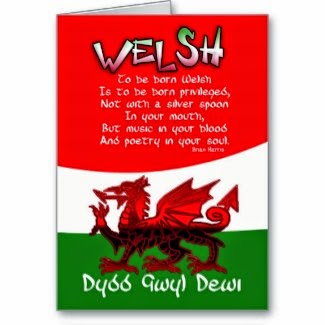St David's Day is celebrated on 1st
March every year.
Who
is St David?
Saint David is the patron saint of Wales.
Very little is known about St David for certain. The little
information there is - is based on an account of his life written by Rhigyfarch
towards the end of the 11th century therefore we are unsure how much of the
historical manuscripts are fact as opposed to legend.
St David (Dewi Sant) was
born towards the end of the fifth century. He was a Celtic monk / abbot and
bishop who also became the archbishop of Wales. During his life he helped spread
the word of Christianity to pagan tribes across Wales and western England.
It is claimed that Saint
David was a tall and physically strong man who allegedly ate a very frugal diet
of bread and herbs. It is also claimed that he drank only water.
The most famous story about
Saint David tells how he was preaching to a huge crowd and the ground is said
to have risen up so that he was standing on a hill and everyone had a better
chance of seeing and hearing him.
St
David’s Day Celebrations
Cardiff:
Parades are held throughout
Wales to celebrate St David’s Day with the largest parade being held in Cardiff.
The parade is formally attended by either the Queen or the Prince of Wales and
is a mixture of both folklore and military tattoo. Other than the parade –
celebrations include concerts & festivals.
Colwyn Bay:
Colwyn Bay:
An annual parade through the town centre is now
held with several hundred citizens and schoolchildren taking part with other
events centred around the parade.
Prestatyn closes
the top of the High Street – this is to allow local schools to participate in
Welsh singing and local fundraising.
St David's Week festival was
inaugurated in Swansea in 2009 with a variety of musical / sporting and
cultural events being held throughout the city to mark the national day.
 Organises yearly events to celebrate St. David's
Day which include a Welsh themed week of fireworks / parades and Disney
characters dressed in traditional Welsh attire.
Organises yearly events to celebrate St. David's
Day which include a Welsh themed week of fireworks / parades and Disney
characters dressed in traditional Welsh attire.
St. David's Day Festival - National Day of Wales is
the largest annual event of its kind in the United States encompassing an eisteddfod
(this is a Welsh festival of music / literature and performance) / Celtic marketplace / classes
and a concert.
What
are the national emblems of Wales?
The national emblems of
Wales are dragons / daffodils and leeks.
Dragons:
The dragon has come to symbolise the fiery Welsh nation who are proud
and defiant in the face of adversity (usually in battles with the English).
Legend claims the symbol of the red dragon was sported on a crest by
Arthur - son of Uthr Bendragon. It has been said that the father saw a dragon
in the sky predicting his son would be king.
Other trains of thought believe the dragon
symbol probably found its way into Wales via Rome - when the Roman legions
arrived on Welsh shores sporting the mythical / fire-breathing creature as an
emblem.
During the Medieval era Welsh poets would compare their
brave leaders to dragons and between 1485 and 1603 the dragon formed part of
the arms of the Tudor dynasty.
The dragon re-surfaced again in the 19th century when it
appeared as the royal badge for Wales in 1807. From then onwards the red dragon
was frequently used as a symbol in Welsh patriotic societies and was finally
officially recognised by the Queen in 1959.
St David's Day is
commemorated by the wearing of daffodils or leeks. Both plants are
traditionally regarded as national emblems.
Leeks:
 There are many explanations
of how the leek came to be adopted as the national emblem of Wales – a few are:
There are many explanations
of how the leek came to be adopted as the national emblem of Wales – a few are:
· One is
that St David advised the Welsh on the eve of battle with the Saxons to wear
leeks in their caps to distinguish friend from foe.
·
It was believed that
eating leeks encouraged good health and happiness
· Shakespeare
mentions in Henry V that the Welsh archers wore leeks at the battle of
Agincourt in 1415.
Daffodils:
 In total contrast the daffodil is a much younger emblem that gained
popularity in the 19th century. Women were especially fond of the bright /
cheerful flower as an emblem of Wales.
In total contrast the daffodil is a much younger emblem that gained
popularity in the 19th century. Women were especially fond of the bright /
cheerful flower as an emblem of Wales.
At the beginning of the 20th century it became even more closely
associated with the Principality when Welshman and British Prime Minster David
Lloyd George wore it on St David's Day and at ceremonies to mark the
investiture of the then Prince of Wales.
What
is the National Dress of Wales?
On St David's Day some
children in Wales dress in their national costume which consists of:
·
white
frilled cap
·
long
dress
The
flag of St David:
The
National Flag of Wales:
The national flag of Wales
depicts a fiery red dragon (Y Ddraig Goch) against a green and white
background.
By Andria Owen








